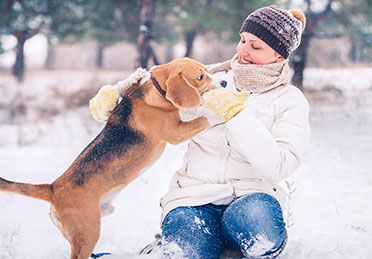
As spring time and warmer weather return, you may notice your older dog breathing heavier and not being able to play as long as he once had. Many pet owners attribute this to aging, but heavy breathing and exercise intolerance are not always just due to old age.
Laryngeal paralysis is a disorder of geriatric large breed dogs where the larynx (the opening to the trachea or breathing tube) is not able to open as it should when the dog inhales. This is due to a failure of the recurrent laryngeal nerve that innervates the muscles of the larynx. As a result, the airway remains closed and dogs are not able to get enough air into their lungs when they inhale. Clinical signs include loud breathing and panting, a change in bark, a dusky bluish color to the mucous membranes when exerted and in severe cases or in a crisis, collapse and potentially death.
The cause of laryngeal paralysis is not fully known, but may be part of a generalized neuromuscular disorder. Patients should be evaluated for underlying causes such as a low thyroid level, masses in the neck or chest or other neurologic disease.

Treatment of this disorder typically involves surgery to pull one side of the Laryngeal paralysis open and hold it in an open position called a laryngeal “tie-back” procedure. Possible complications postoperatively include aspiration pneumonia (due to food or water getting into the lungs) or failure of the suture holding the larynx open leading to a recurrence of clinical signs. Aspiration pneumonia is treated with antibiotics and dogs can recover quickly if diagnosed early.
If you feel your dog is showing signs of laryngeal paralysis, talk to your family veterinarian about a consultation with one of our surgeons.

